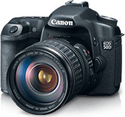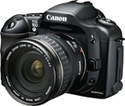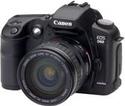The Journey Continues.
The EOS Rebel T1i is packed with features, both refined and new. In addition to its admirable performance with an all-new 15.1 Megapixel Canon CMOS sensor, DIGIC 4 Image Processor, a 3.0-inch Clear View LCD with anti-reflective and scratch-resistant coating, and compatibility with the EOS System of lenses and Speedlites, the EOS Rebel T1i adds remarkable Full HD video capture at resolutions up to 1920 x 1080. An HDMI port allows for quick connections to high definition TVs and monitors for easy viewing of your stills and video. The entire operation is simple and easy even if you are a beginner. You'll have uncompromised EOS Digital performance with power and flexibility right in the palm of your hand.
High Resolution Still Capture.
Canon's CMOS (complementary metal oxide semiconductor) sensor captures images with exceptional clarity and tonal range and offers the most pixels in its class. It offers many of the same new technologies as used by Canon's professional cameras to maximize each pixel's light gathering efficiency. Its APS-C size sensor creates an effective 1.6x field of view (compared to 35mm format). Canon's DIGIC 4 Image Processor dramatically speeds up all camera operations for intuitive operation and offers improvements in both fine detail and natural color reproduction. It works in concert with the EOS Rebel T1i's image sensor to achieve unprecedented levels of performance in all lighting situations.
DIGIC 4 Image Processor
With the EOS Rebel T1i, analog to digital signal conversion is executed by a 14-bit processor, which generates digital data with incredibly smooth tones. A feature that originally appeared in top-of-the-line pro digital SLR cameras, the 14-bit conversion gives incredibly smooth transitions from light to dark colors with far less risk of "banding." A sky at sunset is a perfect example. With this rich 14-bit gradation, the EOS Rebel T1i offers RAW images of the highest quality that can be processed with Canon's Digital Photo Professional software. Even JPEG files, which are always finished at 8-bits per channel, use the full 14-bit conversion initially to generate the best possible color and tonal detail.
The EOS Rebel T1i is packed with features, both refined and new. In addition to its admirable performance with an all-new 15.1 Megapixel Canon CMOS sensor, DIGIC 4 Image Processor, a 3.0-inch Clear View LCD with anti-reflective and scratch-resistant coating, and compatibility with the EOS System of lenses and Speedlites, the EOS Rebel T1i adds remarkable Full HD video capture at resolutions up to 1920 x 1080. An HDMI port allows for quick connections to high definition TVs and monitors for easy viewing of your stills and video. The entire operation is simple and easy even if you are a beginner. You'll have uncompromised EOS Digital performance with power and flexibility right in the palm of your hand.
High Resolution Still Capture.
Canon's CMOS (complementary metal oxide semiconductor) sensor captures images with exceptional clarity and tonal range and offers the most pixels in its class. It offers many of the same new technologies as used by Canon's professional cameras to maximize each pixel's light gathering efficiency. Its APS-C size sensor creates an effective 1.6x field of view (compared to 35mm format). Canon's DIGIC 4 Image Processor dramatically speeds up all camera operations for intuitive operation and offers improvements in both fine detail and natural color reproduction. It works in concert with the EOS Rebel T1i's image sensor to achieve unprecedented levels of performance in all lighting situations.
DIGIC 4 Image Processor
With the EOS Rebel T1i, analog to digital signal conversion is executed by a 14-bit processor, which generates digital data with incredibly smooth tones. A feature that originally appeared in top-of-the-line pro digital SLR cameras, the 14-bit conversion gives incredibly smooth transitions from light to dark colors with far less risk of "banding." A sky at sunset is a perfect example. With this rich 14-bit gradation, the EOS Rebel T1i offers RAW images of the highest quality that can be processed with Canon's Digital Photo Professional software. Even JPEG files, which are always finished at 8-bits per channel, use the full 14-bit conversion initially to generate the best possible color and tonal detail.





